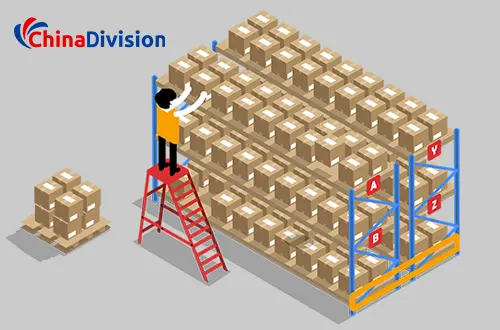The Impact of Automatic Replenishment on Peak Sales Season
Have you ever experienced an inability to meet demand during peak sales seasons, resulting in a decrease in overall revenue and profitability? Out-of-stocks cause dissatisfied customers to abandon their carts or switch to competitors, resulting in lost sales and potentially long-term damage to a brand's reputation. Shortages can cause inventory to be unevenly distributed, with some products in excess and others in shortage. Are you still troubled by these problems caused by inventory management? Through the following solutions provided by ChinaDivision, you will say goodbye to these problems and increase your sales and profits to a new level.
What are the adverse effects of out-of-stock inventory?
customer dissatisfaction
Out-of-stock items can lead to unsatisfied customers because shoppers may not be able to find the products they want. Customers may perceive the brand as unreliable and may be hesitant to shop with the retailer in the future.
supply chain disruption
Warehouse shortages may indicate broader supply chain disruptions, such as delays in manufacturing or shipping. Supply chain issues can have a knock-on effect, affecting the entire fulfillment process and causing delays throughout the distribution network.
Key products are out of stock
Shortages of essential or popular products can have a more pronounced impact on overall sales and customer satisfaction. This can be especially challenging if key products, such as seasonal or promotional items, are unavailable.
Brand reputation damaged
Persistent stock-outs during peak sales seasons can damage a brand's reputation.
Missed marketing opportunities
Retailers may not be able to maximize the impact of their marketing campaigns during peak sales periods.
Inventory imbalance
This imbalance can impact overall inventory management and can lead to clearance sales or excess inventory.
Decreased revenue and profits
Retailers may be missing out on opportunities to take advantage of the increased consumer spending characteristic of these periods. If the products being promoted are unavailable due to shortages, marketing efforts and promotions may not have the desired effect.
Increased operating costs
Shortages can result in rushed and expedited shipments, increasing shipping and fulfillment costs. Rushed operations can also result in higher labor costs, as additional personnel may be needed to handle urgent tasks. Customer service teams also face a large number of inquiries and complaints related to product availability, and handling customer complaints and providing explanations for out-of-stock products can strain customer service resources.

The peak sales season, often associated with events such as Black Friday, Cyber Monday or holiday shopping, is characterized by a surge in consumer demand. Automated warehouse replenishment can impact and improve operational efficiency during peak sales seasons in several ways:
Optimize inventory levels
Automated replenishment systems use real-time data and historical sales patterns to accurately forecast demand.
Maintaining optimized inventory levels ensures products are available to meet customer demand without excess inventory, thereby reducing the risk of stockouts or overstocking.
Reduce out-of-stocks
By automatically replenishing items after they reach a certain threshold, you can minimize the possibility of running out of stock during peak sales periods.
Avoiding stock-outs during peak seasons is crucial because customers are more likely to switch to competitors if the desired product is not available.
Improve order fulfillment speed
Automated systems can generate replenishment orders in a timely manner, reducing the time between order placement and fulfillment.
During peak sales periods, when customers expect fast delivery, faster order processing is critical and can increase customer satisfaction and loyalty.
Improve demand forecast accuracy
Automated replenishment systems use advanced algorithms and machine learning to improve the accuracy of demand forecasts.
Accurate forecasts enable retailers to adjust inventory levels based on expected demand and avoid stock-outs and overstocking.
Improve operational efficiency
Automation streamlines the replenishment process, reducing the need for manual intervention and minimizing the risk of human error.
Improved operational efficiencies allow retailers to focus on customer service and other aspects of the experience during peak sales periods.
save costs
Efficient replenishment reduces the likelihood of excess inventory, which can lead to liquidation sales or increased carrying costs.
Cost savings achieved through optimized inventory management help improve profitability, especially during peak demand seasons.
Flexibility and scalability
The automated replenishment system is scalable and can adapt to fluctuations in demand during peak seasons.
The ability to scale operations up or down based on demand helps retailers respond effectively to changing market conditions.
The value that automated warehouse replenishment brings to peak sales seasons
maintain inventory levels
During the peak sales season, the warehouse automatic replenishment system can ensure that inventory levels are replenished in a timely manner and avoid affecting sales due to insufficient inventory.
Improve customer satisfaction
Timely replenishment can ensure that customer needs are met and avoid stockouts, thereby improving customer satisfaction.
Optimize inventory management
Automated replenishment systems can optimize inventory levels through real-time data analysis and prediction, avoiding the risks of over-stocking and under-stocking.
Improve operational efficiency
Periodic Automatic Replenishment can reduce manual intervention and errors, improve replenishment efficiency and accuracy, and thereby optimize the entire operation process.
cut costs
By optimizing inventory levels and improving operational efficiency, automated warehouse replenishment can reduce inventory costs and operating costs, thereby increasing overall profitability.
Enhance supply chain stability
The automatic replenishment system can enhance the stability of the supply chain, ensure sufficient supply during peak sales seasons, and avoid supply chain risks caused by shortages.
Realize intelligent decision-making
The automatic replenishment system can provide decision makers with more accurate and timely replenishment suggestions through data analysis and machine learning, thereby optimizing sales strategies and improving sales performance.
ChinaDivision provides a user-friendly WMS user center that can be accessed with one click anytime and anywhere around the world. Inventory, order, and bill logs are updated in real time to help customers understand and grasp order changes in real time, respond to inventory quantity issues as soon as possible, and effectively reduce the probability of out-of-stocks. Up to 99%. Why don't you try this system soon? Solve your problem of insufficient inventory management and increase product sales.





